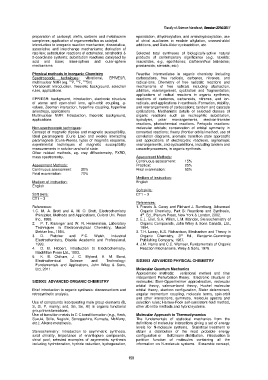Page 196 - handbook 20162017
P. 196
Faculty of Science Handbook, Session 2016/2017
preparation of carbonyl, olefin, carbene and metallocene epoxidation, dihydroxylation, and aminohydroxylation, use
complexes; application of organometallics as catalyst. of chiral auxiliaries in enolate alkylation, crossed-aldol
Introduction to inorganic reaction mechanism; dissociative, additions, and Diels-Alder cycloaddition, etc.
associative and interchange mechanisms; derivation of
rate law; substitution reactions of octahedral, tetrahedral & Selected total syntheses of biologically-active natural
5-coordinate systems; substitution reactions catalysed by products of contemporary significance (e.g., taxoids;
acid and base; inner-sphere and outer-sphere macrolides, e.g., epothilones; Catharanthus bisindoles;
mechanisms prostanoids; steroids; etc.).
Physical methods in Inorganic Chemistry Reactive intermediates in organic chemistry including
Spectroscopic techniques: vibrational, EPR/ESR, carbocations, free radicals, carbenes, nitrenes, and
31
19
multinuclear NMR (eg. P, F, 119 Sn) radical-ions. Chemistry of free radicals: reactions and
Vibrational: Introduction, theoretic background, selection mechanisms of free radicals including abstraction,
rules, applications. addition, rearrangement, cyclization and fragmentation;
applications of radical reactions in organic synthesis;
EPR/ESR: background, introduction, electronic structure reactions of carbenes, carbenoids, nitrenes, and ion-
of atoms and open-shell ions, spin-orbit coupling, g- radicals, and applications in synthesis. Formation, stability,
values, Zeeman interaction, hyperfine coupling, hyperfine and rearrangements of carbocations; tandem and cascade
anisotropy, applications cyclizations. Mechanistic details of selected classes of
Multinuclear NMR: Introduction, theoretic background, organic reactions such as nucleophilic substitution,
applications hydrolysis, polar rearrangements, electron-transfer
reactions, photochemical reactions. Pericyclic reactions:
Non-spectroscopic techniques: molecular orbitals; conservation of orbital symmetry in
Concept of magnetic dipoles and magnetic susceptibility, concerted reactions; theory (frontier orbital method, use of
Ideal paramagnets (Curie Law) and weakly interacting correlation diagrams, aromatic transition state approach)
paramagnets (Curie-Weiss), types of magnetic response, and applications of electrocyclic reactions, sigmatropic
experimental techniques of magnetic susceptibility rearrangements, and cycloadditions, including tandem and
measurements in solution and solid state. cascade processes, in organic synthesis.
Other related methods, eg. xray diffractometry, PXRD,
mass spectrometry. Assessment Methods:
Continuous assessment: 15%
Assessment Methods: Practical: 25%
Continuous assessment: 30% Final examination: 60%
Final examination: 70%
Medium of instruction:
Medium of instruction: English
English
Soft skills:
Soft skills: CT1 – 3
CT1 – 3
References:
References: 1. Francis A. Carey and Richard J. Sundberg, Advanced
1.C. M. A. Brett and A. M. O. Brett, Electrochemistry Organic Chemistry, Part B: Reactions and Synthesis,
Principles, Methods and Applications, Oxford Uni. Press 4 . Ed., Plenum Press, New York & London, 2002.
th
Inc., 1993. 2. E.L. Eliel, S.H. Wilen, L.M. Mander, Stereochemistry of
2. P. T. Kissinger and W. R. Heinemmen, Laboratory Organic Compounds, John Wiley & Sons Canada, Ltd.,
Techniques in Electroanalytical Chemistry, Marcel 1994.
Dekker Inc., 1984. 3. T.H. Lowry, K.S. Richardson, Mechanism and Theory in
3. D. Pletcher and F.C. Walsh, Industrial Organic Chemistry, 3 rd Ed., Benjamin-Cummings
Electrochemistry, Blackie Academic and Professional, Publishing Company, 1987.
1993. 4. J.M. Harris and C.C. Wamser, Fundamentals of Organic
4. D. B. Hibbert, Introduction to Electrochemistry, Reaction Mechanisms, Wiley & Sons, 1976.
MacMillan Press Ltd., 1993.
5. K. B. Oldham, J. C. Myland, A. M. Bond,
Electrochemical Science and Technology: SID3003 ADVANCED PHYSICAL CHEMISTRY
Fundamentals and Applications, John Wiley & Sons,
Ltd, 2011. Molecular Quantum Mechanics
Approximate methods: variational method and time
independent Perturbation theory; Electronic structure of
SID3002 ADVANCED ORGANIC CHEMISTRY molecules: Born-Oppenheimer approximation, molecular
orbital theory, valence-bond theory, Huckel molecular
Brief introduction to organic synthesis: disconnections and orbital theory, electron configuration, Slater determinant,
retrosynthetic analysis. angular momentum coupling, molecule terms, spin-orbit
and other interactions, symmetry, molecule spectra and
Use of compounds incorporating main group elements (B, selection rules; Hartree-Fock self-consistent-field method,
S, Si, P, mainly; and, Sn, Se, Al) in organic functional other ab initio methods and hybrid systems.
group transformations;
Use of transition metals in C-C bond formation (e.g., Heck, Molecular Approach to Thermodynamics
Suzuki, Stille, Negishi, Sonogashira, Kumada, McMurry, The fundamentals of statistical mechanics from the
etc.); Alkene metathesis. definitions of molecular interactions giving a set of energy
levels for N-molecule systems. Statistical treatment to
Stereochemistry: Introduction to asymmetric synthesis, obtain a distribution of the most probable energy
axial chirality, importance of enantiopure compounds, configuration or Boltzmann distribution. Introduction to
chiral pool; selected examples of asymmetric synthesis partition function of molecules containing all the
including hydroboration, hydride reduction, hydrogenation, information on N-molecule systems. Ensemble concept,
190

